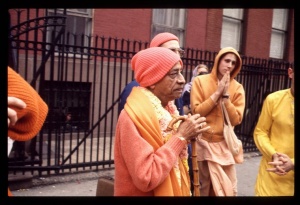CC Madhya 20.307: Difference between revisions
m (1 revision(s)) |
No edit summary |
||
| Line 1: | Line 1: | ||
{{ | [[Category:Sri Caitanya-caritamrta - Madhya-lila Chapter 20|C307]] | ||
<div style="float:left">'''[[Sri Caitanya-caritamrta|Śrī Caitanya-caritāmṛta]] - [[CC Madhya|Madhya-līlā]] - [[CC Madhya 20|Chapter 20: Lord Śrī Caitanya Mahāprabhu Instructs Sanātana Gosvāmī in the Science of the Absolute Truth]]'''</div> | |||
<div style="float:right">[[File:Go-previous.png|link=CC Madhya 20.306|Madhya-līlā 20.306]] '''[[CC Madhya 20.306|Madhya-līlā 20.306]] - [[CC Madhya 20.308|Madhya-līlā 20.308]]''' [[File:Go-next.png|link=CC Madhya 20.308|Madhya-līlā 20.308]]</div> | |||
{{CompareVersions|CC|Madhya 20.307|CC 1975|CC 1996}} | |||
{{RandomImage}} | |||
==== TEXT 307 ==== | ==== TEXT 307 ==== | ||
<div | <div class="verse"> | ||
nijāṁśa-kalāya kṛṣṇa tamo-guṇa aṅgīkari’ | :nijāṁśa-kalāya kṛṣṇa tamo-guṇa aṅgīkari’ | ||
saṁhārārthe māyā-saṅge rudra-rūpa dhari | :saṁhārārthe māyā-saṅge rudra-rūpa dhari | ||
</div> | </div> | ||
| Line 12: | Line 16: | ||
==== SYNONYMS ==== | ==== SYNONYMS ==== | ||
<div | <div class="synonyms"> | ||
nija- | ''nija-aṁśa''—of His personal plenary expansion; ''kalāya''—by an expansion known as ''kalā''; ''kṛṣṇa''—Lord Kṛṣṇa; ''tamaḥ-guṇa''—the material mode of darkness; ''aṅgīkari’''—accepting; ''saṁhāra-arthe''—for the purpose of dissolution; ''māyā-saṅge''—in association with the external energy; ''rudra-rūpa''—the form of Rudra; ''dhari''—assumes. | ||
</div> | </div> | ||
| Line 19: | Line 23: | ||
==== TRANSLATION ==== | ==== TRANSLATION ==== | ||
<div | <div class="translation"> | ||
“Lord Kṛṣṇa, the Supreme Personality of Godhead, expands a portion of His plenary portion and, accepting the association of the material mode of ignorance, assumes the form of Rudra to dissolve the cosmic manifestation. | “Lord Kṛṣṇa, the Supreme Personality of Godhead, expands a portion of His plenary portion and, accepting the association of the material mode of ignorance, assumes the form of Rudra to dissolve the cosmic manifestation. | ||
</div> | </div> | ||
| Line 26: | Line 30: | ||
==== PURPORT ==== | ==== PURPORT ==== | ||
<div | <div class="purport"> | ||
This is a description of the Rudra form, which is another expansion of Kṛṣṇa. Only viṣṇu-mūrtis are expansions of Kṛṣṇa’s personal and plenary portions. Mahā-Viṣṇu, who lies on the Causal Ocean, is an expansion of Saṅkarṣaṇa. When Garbhodakaśāyī Viṣṇu accepts the material modes of nature for the purpose of dissolving the cosmic manifestation, His form is called Rudra. As already explained, Lord Viṣṇu is the controller of māyā. How, then, can He associate with māyā? The conclusion is that the incarnation of Lord Śiva or Lord Brahmā indicates the absence of the supreme power of Viṣṇu. When the supreme power is not there, it is possible to associate with māyā, the external energy. Lord Brahmā and Lord Śiva are to be considered creations of māyā. | This is a description of the Rudra form, which is another expansion of Kṛṣṇa. Only ''viṣṇu-mūrtis'' are expansions of Kṛṣṇa’s personal and plenary portions. Mahā-Viṣṇu, who lies on the Causal Ocean, is an expansion of Saṅkarṣaṇa. When Garbhodakaśāyī Viṣṇu accepts the material modes of nature for the purpose of dissolving the cosmic manifestation, His form is called Rudra. As already explained, Lord Viṣṇu is the controller of ''māyā''. How, then, can He associate with ''māyā''? The conclusion is that the incarnation of Lord Śiva or Lord Brahmā indicates the absence of the supreme power of Viṣṇu. When the supreme power is not there, it is possible to associate with ''māyā'', the external energy. Lord Brahmā and Lord Śiva are to be considered creations of ''māyā''. | ||
</div> | </div> | ||
__NOTOC__ | |||
<div style="float:right; clear:both;">[[File:Go-previous.png|link=CC Madhya 20.306|Madhya-līlā 20.306]] '''[[CC Madhya 20.306|Madhya-līlā 20.306]] - [[CC Madhya 20.308|Madhya-līlā 20.308]]''' [[File:Go-next.png|link=CC Madhya 20.308|Madhya-līlā 20.308]]</div> | |||
__NOTOC__ | |||
__NOEDITSECTION__ | |||
Revision as of 12:29, 7 September 2021

A.C. Bhaktivedanta Swami Prabhupada
TEXT 307
- nijāṁśa-kalāya kṛṣṇa tamo-guṇa aṅgīkari’
- saṁhārārthe māyā-saṅge rudra-rūpa dhari
SYNONYMS
nija-aṁśa—of His personal plenary expansion; kalāya—by an expansion known as kalā; kṛṣṇa—Lord Kṛṣṇa; tamaḥ-guṇa—the material mode of darkness; aṅgīkari’—accepting; saṁhāra-arthe—for the purpose of dissolution; māyā-saṅge—in association with the external energy; rudra-rūpa—the form of Rudra; dhari—assumes.
TRANSLATION
“Lord Kṛṣṇa, the Supreme Personality of Godhead, expands a portion of His plenary portion and, accepting the association of the material mode of ignorance, assumes the form of Rudra to dissolve the cosmic manifestation.
PURPORT
This is a description of the Rudra form, which is another expansion of Kṛṣṇa. Only viṣṇu-mūrtis are expansions of Kṛṣṇa’s personal and plenary portions. Mahā-Viṣṇu, who lies on the Causal Ocean, is an expansion of Saṅkarṣaṇa. When Garbhodakaśāyī Viṣṇu accepts the material modes of nature for the purpose of dissolving the cosmic manifestation, His form is called Rudra. As already explained, Lord Viṣṇu is the controller of māyā. How, then, can He associate with māyā? The conclusion is that the incarnation of Lord Śiva or Lord Brahmā indicates the absence of the supreme power of Viṣṇu. When the supreme power is not there, it is possible to associate with māyā, the external energy. Lord Brahmā and Lord Śiva are to be considered creations of māyā.